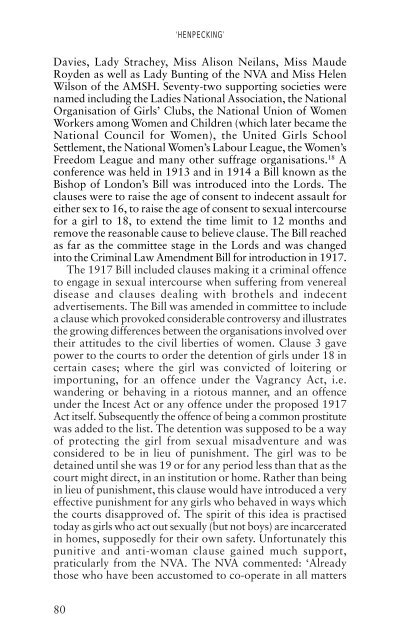The Spinster and Her Enemies - Feminish
The Spinster and Her Enemies - Feminish
The Spinster and Her Enemies - Feminish
Create successful ePaper yourself
Turn your PDF publications into a flip-book with our unique Google optimized e-Paper software.
‘HENPECKING’<br />
Davies, Lady Strachey, Miss Alison Neilans, Miss Maude<br />
Royden as well as Lady Bunting of the NVA <strong>and</strong> Miss Helen<br />
Wilson of the AMSH. Seventy-two supporting societies were<br />
named including the Ladies National Association, the National<br />
Organisation of Girls’ Clubs, the National Union of Women<br />
Workers among Women <strong>and</strong> Children (which later became the<br />
National Council for Women), the United Girls School<br />
Settlement, the National Women’s Labour League, the Women’s<br />
Freedom League <strong>and</strong> many other suffrage organisations. 18 A<br />
conference was held in 1913 <strong>and</strong> in 1914 a Bill known as the<br />
Bishop of London’s Bill was introduced into the Lords. <strong>The</strong><br />
clauses were to raise the age of consent to indecent assault for<br />
either sex to 16, to raise the age of consent to sexual intercourse<br />
for a girl to 18, to extend the time limit to 12 months <strong>and</strong><br />
remove the reasonable cause to believe clause. <strong>The</strong> Bill reached<br />
as far as the committee stage in the Lords <strong>and</strong> was changed<br />
into the Criminal Law Amendment Bill for introduction in 1917.<br />
<strong>The</strong> 1917 Bill included clauses making it a criminal offence<br />
to engage in sexual intercourse when suffering from venereal<br />
disease <strong>and</strong> clauses dealing with brothels <strong>and</strong> indecent<br />
advertisements. <strong>The</strong> Bill was amended in committee to include<br />
a clause which provoked considerable controversy <strong>and</strong> illustrates<br />
the growing differences between the organisations involved over<br />
their attitudes to the civil liberties of women. Clause 3 gave<br />
power to the courts to order the detention of girls under 18 in<br />
certain cases; where the girl was convicted of loitering or<br />
importuning, for an offence under the Vagrancy Act, i.e.<br />
w<strong>and</strong>ering or behaving in a riotous manner, <strong>and</strong> an offence<br />
under the Incest Act or any offence under the proposed 1917<br />
Act itself. Subsequently the offence of being a common prostitute<br />
was added to the list. <strong>The</strong> detention was supposed to be a way<br />
of protecting the girl from sexual misadventure <strong>and</strong> was<br />
considered to be in lieu of punishment. <strong>The</strong> girl was to be<br />
detained until she was 19 or for any period less than that as the<br />
court might direct, in an institution or home. Rather than being<br />
in lieu of punishment, this clause would have introduced a very<br />
effective punishment for any girls who behaved in ways which<br />
the courts disapproved of. <strong>The</strong> spirit of this idea is practised<br />
today as girls who act out sexually (but not boys) are incarcerated<br />
in homes, supposedly for their own safety. Unfortunately this<br />
punitive <strong>and</strong> anti-woman clause gained much support,<br />
praticularly from the NVA. <strong>The</strong> NVA commented: ‘Already<br />
those who have been accustomed to co-operate in all matters<br />
80

















